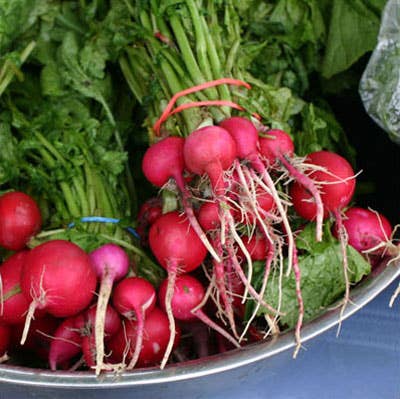
Versatile Radishes
Radishes: the miracle root!
Radishes germinate like lightning, and they grow so quickly that in about three weeks, they've reached maturity and can be picked and eaten. The downside? It can be confusing to figure out how to eat them.
Almost every supermarket carries radishes, but wrack your brains and try to think of more than two ways to serve them, and I guarantee you'll come up empty. They're a giant culinary blind spot. I mean, sure, radishes form the basis of the entire Fraggle economy and Boober Fraggle has made radish en croute and frozen radish bisque. But real, live, non-Muppet humans can be hard-pressed to think of anything to do with radishes besides eat them raw in a salad.
The easiest thing to do with radishes is to take a baguette, spread it with good quality butter, and layer raw, thinly sliced radishes on top. Sprinkle with salt to taste and you're done: it's a surefire snack for yourself, or the easiest appetizer that you can serve at holiday parties. Or, just spread the butter and salt directly on the radishes themselves, eliminating the baguette altogether. Radishes have a slightly peppery taste, and the creamy butter creaminess complements them nicely.
I also highly recommend pickling them. Daikon radishes are the most commonly pickled radishes, but you can also pickle red and white radishes and, in the summer, dip pickled radishes in salt as a snack to go with beer or a glass of wine. Of course, the award for "Best Use of a Pickled Radish" goes to Korean cuisine for radish kimchi, which you can easily make yourself in both a sliced and a cubed version.
If you want to cook radishes, however, you're suddenly in no man's land. The number of good recipes for cooked radishes (that aren't daikons) can be counted on one hand, and opinions are split on whether the results are delicious or horrible. A recipe that can't be argued with is this one for roasted red and white radishes. Roasting radishes is, frankly, an insane idea since radishes have such a high water content. But in this case, it works way better than you'd imagine.
Radish soup is even more controversial. As with broccoli, so much of what we think is the taste of a radish is really its texture. When you divorce the two, you might find that while you loved the crunch, you hate the peppery taste. An easier sell is radish greens soup. Home cooks usually throw away the greens from root vegetables, and that's a shame.
Of course, if none of these recipes appeal to you, then I advise you to go for "cute" and carve any spare radishes you have into a Super Mario mushroom, because everyone likes Super Mario mushrooms. Okay, maybe not, but at least this is proof that radishes are much more versatile than they seem.
Buying Tips
Season: Some people say May through the end of September, and some say October through January, but really, it's a matter of taste, since you can find radishes almost all year round depending on the variety you're eating. In the dry summer months, radishes tend to be more intensely flavored—spicier, more peppery, and slightly more bitter. In the cooler months, they tend to be larger with a higher water content, so their taste isn't quite as intense.
Where to find it: They're easily found both in supermarkets and at local farmers' markets.
Price: $2 for a bunch.
Amanda Cohen is the chef and owner of Dirt Candy, a vegetarian restaurant in New York City.
Keep Reading
Continue to Next Story










